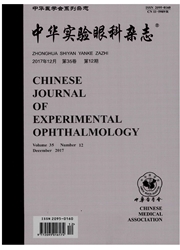

 中文摘要:
中文摘要:
目的探讨在模拟微重力条件下兔角膜基质细胞在复合材料上的三维生长特性,为构建组织工程角膜提供新的途径。方法Ⅱ型胶原酶消化法获取原代兔角膜基质细胞,以密度为1×10^5/mL将第5代细胞种植于无菌复合载体材料上。以模拟微重力条件下培养兔角膜基质细胞为实验组与传统静态培养系统进行细胞培养作对照。分别在6、12、18d取细胞和载体行苏木精-伊红染色光镜观察和扫描电镜观察;在3、6、9、12、15、18d取出行CCK-8法检测细胞增生功能。结果对照组只在材料表面可见单层细胞;实验组大量细胞与载体黏附紧密且生长入载体内部,载体材料降解显著。扫描电镜下实验组可见细胞胞体小且突触丰富,培养第18d细胞在材料表面分泌大量胶原膜样物;模拟微重力系统促进了细胞增生(P=0.004)。结论模拟微重力环境中在复合材料上培养的兔角膜基质细胞接近生理状态,更适用于组织工程三维构建,为构建更接近生理状态的组织工程角膜提供了依据。
 英文摘要:
英文摘要:
Objective It is very difficult for cells to grow into the inner of materials under conventional static culture for tissue engineering. And the keratocytes are quite different from the native ones. This research intend to explore the three- dimensional characteristics of rabbit corneal keratocytes in the composite materials under the simulated microgravity,and provide a new method to construct tissue engineering cornea. Methods Primary rabbit corneal keratocytes were obtained by digesting the stoma using type U collagenase. The fifth passage of keratocytes were cultured on the composite materials at a density of 1 × 10^5cells/ mL. Simulated microgravity culture of keratocytes was used as experimental group, and conventional static culture was used as control group. The carriers were taken out at 6,12, 18 days separately for the histological examination under the light microscope and scanning electron microscope and for the evaluation of proliferation of corneal keratocytes at 3,6,9,12,15,18 days separately with CCK-8 test. Results In experimental groups,more keratocytes adhered to the surface and grew into the matrix of the carrier and the carrier was degraded more lastly. Keratocytes were seen on the carrier surfaces only in control group. Compared with control groups,more keratocytes were observed in experimental groups (P = 0. 004) , and the keratocytes were smaller and developed more foot and secreted more collagen in 18 days. Conclusion The morphology of cultured keratocytes under the simulated microgravity is similar to that of physiological condition. Simulated microgravity culture can supply better condition to three-dimensional reconstruction. The research provides a basis for the construction of bioengineering corneal stoma close to native tissue in vitro.
 同期刊论文项目
同期刊论文项目
 同项目期刊论文
同项目期刊论文
 期刊信息
期刊信息
